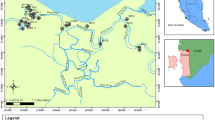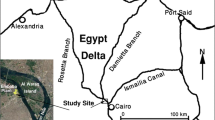Abstract
Riverbank filtration (RBF) is a process during which river water is subjected to subsurface flow prior to abstraction wells, often characterized by improved water quality. The induced infiltration of river water through the riverbed also creates a clogging layer. This decreases riverbed permeability and abstraction rates, particularly if the river water has high turbidity, as in Thailand. As Chiang Mai Province is one of the most favorable sites for future RBF construction in Thailand, two sites, Mae Rim and San Pa Tong, were selected to simulate clogging by using a channel experiment. The mobile experimental apparatus was set up at the bank of the river in order to use fresh river water. Riverbed sediment was used as channel bed and filling material for the columns. The aim was to simulate riverbed clogging using river water with high turbidity and determine the effect of clogging, which can be quantified using vertical hydraulic conductivity (Kv). An increase in channel flow velocity caused partial removal of a clogging layer in only the top 0.03 m of the sediment column. The combination of low channel flow and high turbidity leads to much more clogging than high channel flow and low turbidity. A complete manual removal of the external clogging layer led to an increase in Kv, but the initial Kv values were not recovered. The external clogging had a lower effect on Kv than internal clogging. For planning new RBF sites along high-turbidity rivers, reduction in Kv to estimate RBF well yield cannot be calculated based only on initial Kv but requires field experiments.








Similar content being viewed by others
References
Archwichai L, Srisuk K, Chusanatus S, Pholkern K, Munyou S, Saraphirom P (2011) Managed aquifer recharge studies in the Lower Northern Region River Basin of Thailand. GEOINDO2011 Conference, 1–3 Dec 2011, KhonKaen, Thailand
ASTM International (2007) Standard Test method for particle-size analysis of soils. Designation: D422–63
Busch K-F, Luckner L, Tiemer HC (1993) Geohydraulics. Lehrbuch der Hydrogeologie, vol 3. Gebrueder Borntraeger, Berlin, Stuttgart (in German)
Cunningham AB, Anderson CJ, Bouwer H (1987) Effects of sediment-laden flow on channel bed clogging. J Irrig Drain Eng 113(1):106–118
Department of Groundwater Resources (2013) Final report of large scale groundwater resources development using modern riverbank filtration technology “Phase 1: Feasibility study on large scale groundwater resources development using modern riverbank filtration (rbf) technology”. Department of Groundwater Resources (DGR), Thailand (in Thai)
Department of Mineral Resources (2007) Geological map in scale 1:50000. Department of Mineral Resources (DMR), Ministry of Natural Resources and Environment, Thailand
Freeze RA (1994) Henry Darcy and the fountains of Dijon. Ground Water 32(1):23–30
Grischek T, Macheleidt W, Nestler W (2002) River bed specifics and their effect on bank filtration efficiency. In: Dillon PJ (ed) Management of aquifer recharge for sustainability. Balkema Publishers, London, pp 59–64
Heeger D (1987) Investigations on clogging of river beds. Dissertation, Division of Water Sciences, TU Dresden (in German)
Hubbs SA (2006a) Evaluating streambed forces impacting the capacity of riverbed filtration systems. In: Hubbs SA (ed) Riverbank filtration hydrology. Proceeding of NATO Advanced Research Workshop on Riverbank Filtration Hydrology, Sept 2004, Bratislava, Slovakia, Springer Netherlands, pp 21–42
Hubbs SA (2006b) Changes in riverbed hydraulic conductivity and specific capacity at Louisville. In: Hubbs SA (ed) Riverbank filtration hydrology. Proceeding of NATO Advanced Research Workshop on Riverbank Filtration Hydrology, Sept 2004, Bratislava, Slovakia, Springer Netherlands, pp 199–220
Kuehn W, Mueller U (2000) River bank filtration—an overview. J. AWWA 92(12):60–69
Macheleidt W, Grischek T, Nestler W (2006) New approaches for estimating streambed infiltration rates. In: Hubbs SA (ed) Riverbank filtration hydrology. Proceeding of NATO Advanced Research Workshop on Riverbank Filtration Hydrology, Sept 2004, Bratislava, Slovakia, Springer Netherlands, pp 73–91
Ministry of Public Health (1991) Thailand drinking water quality in seal container standards. Notification Ministry of Public Health, No. 61, B.E. 2524 (1981), published in the Royal Gazette, vol. 2, dated Feb 26, B.E. 2534 (1991)
National Statistical Office (2012) Key statistic of Thailand 2012. Ministry of information and communication technology. Department of groundwater resources (2013), Bangkok (in Thai)
Pavelic P, Dillon PJ, Mucha M, Nakai T, Barry KE, Bestland E (2011) Laboratory assessment of factors affecting soil clogging of soil aquifer treatment systems. Wat Res 45(10):3153–3163
Pollution Control Department (1978) Thailand drinking water quality standards. Notification of the Ministry of Industry, No. 322, B.E. 2521 (1978), issued under the Industrial Products Standards Act B.E. 2511 (1968), published in the Royal Gazette, vol. 95, part 68, dated July 4, B.E. 2521 (1978)
Pollution Control Department (2012) Ministry of Natural Resources and Environment. Pollution Control Department (PCD), Bangkok, Thailand. http://www.pcd.go.th/indexEng.cfm. Accessed 1 Sept 2012 (in Thai)
Pollution Control Department (2013) Surface water quality data from 2007 to 2012. Ministry of Natural Resources and Environment. Pollution Control Department (PCD), Bangkok (in Thai)
Provincial Waterworks Authority (2012) The development of water resources. Provincial Waterworks Authority (PWA), Available via http://wr.pwa.co.th/index2.php?id2=00&&part=1&&wreg=9&&w_year=2012. Accessed 12 April 2012 (in Thai)
Riesen SV (1975) Decreasing bank filtrate portion due to clogging of riverbeds (Uferfiltratverminderung durch Selbstdichtung an Gewässersohlen). Dissertation, Faculty for Civil Engineering and Surveyllance, University Karlsruhe (in German)
Royal irrigation department (2009) River profile and elevation—monitoring. Report hydrology and water management center for upper northern region (Chiang Mai Thailand), office of water management and hydrogeology, royal irrigation department, Thailand (in Thai)
Royal irrigation department (2011) runoff—monitoring. Report hydrology and water management center for upper northern region (Chiang Mai Thailand), office of water management and hydrogeology, royal irrigation department, Thailand (in Thai)
Schälchli U (1992) The clogging of coarse gravel river beds by fine sediment. Hydrobiologia 235/236(1):189–197
Schubert J (2002) Hydraulic aspects of riverbank filtration—field studies. J Hydrol 266(3–4):145–161
Schubert J (2006) Experience with riverbed clogging along the Rhine river. In: Hubbs SA (ed) Riverbank Filtration Hydrology. Proceeding of NATO Advanced Research Workshop on Riverbank Filtration Hydrology, Sept 2004, Bratislava, Slovakia, Springer Netherlands, pp 221–242
Velickovic B (2005) Colmation as one of the processes in interaction between the groundwater and surface water. Facta Univ Series Archit Civil Eng 3(2):165–172
Acknowledgments
The Asian Development Bank supported the research under the program “Pilot and Demonstration Activity for water (PDA)”. Federal Ministry of Education and Research of Germany (BMBF grant 01DP12019), KhonKaen University and National Science and Technology Development Agency of Thailand are acknowledged for partial financial support. The Department of Groundwater Resources, Thailand, kindly provided significant riverbank filtration data and helpful collaboration of this study and The Department of Geological Sciences, Chiang Mai University, is acknowledged for providing facilities and field work assistances.
Author information
Authors and Affiliations
Corresponding author
Rights and permissions
About this article
Cite this article
Pholkern, K., Srisuk, K., Grischek, T. et al. Riverbed clogging experiments at potential river bank filtration sites along the Ping River, Chiang Mai, Thailand. Environ Earth Sci 73, 7699–7709 (2015). https://doi.org/10.1007/s12665-015-4160-x
Received:
Accepted:
Published:
Issue Date:
DOI: https://doi.org/10.1007/s12665-015-4160-x




